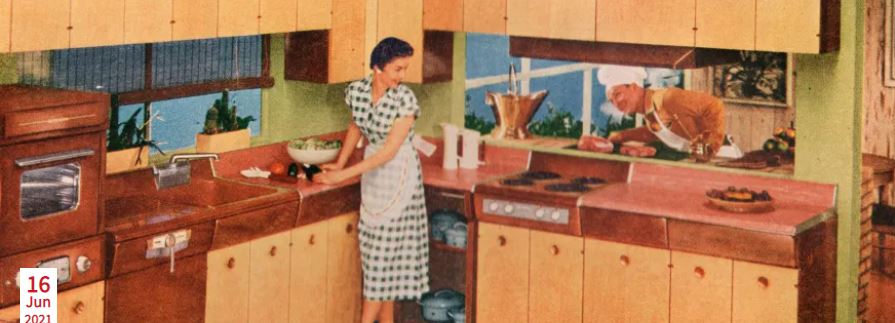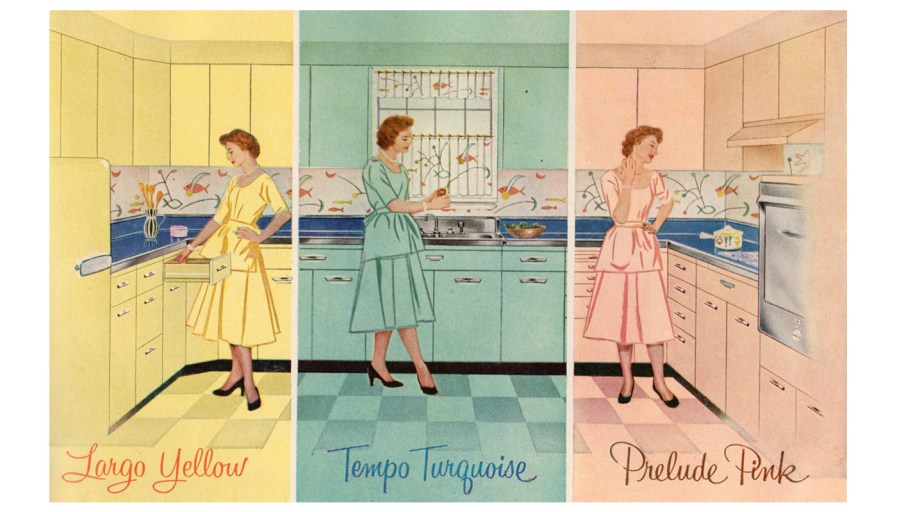
The kitchen says a lot about a home, and the period it was last updated! Canadian families spend a lot of time in this high-traffic room, so it stands to reason we get the itch to revamp them every so often. Here’s a quick history of some standout kitchen décor trends from the last 50+ years.

1950s: Pastel palettes
As soldiers returned home from war, they brought with them a new wave of prosperity, and record-breaking rates of building suburban family homes. Whereas previous decades saw small kitchens tucked away, these retro kitchens were meant to be seen. Easy-to-clean and widely available from post-war factories, candy-coloured steel cabinetry became popular. Matching was key, with dishware and appliances all echoing the bright, optimistic colour scheme. Yellows, blues, and pinks really made their mark throughout the 1950s. The pink scheme was also seen across bathrooms in the ‘50s (for better or for worse).

1960s: Wowing with wood
In this modernity-crazed, fun-loving decade, entertaining at home was all the rage. This iteration of retro kitchen was all about over-the-top details and ambiance. While cabinetry looked to wood, countertops and flooring started to become more vibrant to make up for a loss of colour in the kitchen. With the popularization of plastic in this decade came along with it all sorts of quirky novelty finishes, from faux stained glass to colourful formica. While wood features can still be seen in kitchens today, it was the 1960s that really brought this trend to life.

1970s: Clash culture
Many influences went into the ‘70s décor aesthetic—and it shows. The sleek lines of the ‘50s meet the hippie hangover of the ‘60s, resulting in a symphony of colours and textures never seen before. Kitchens began to feature appliances and furnishings in saturated avocado green, brown, and orange, alongside vinyl upholstery, fringe, and more. Harvest yellow and wood features were also a huge trend in the 1970s, sticking around until the early ‘80s.

1980s: Totally tiled
Kitchens in the 1980s said goodbye to avocado green appliances and hello to a more subdued aesthetic. Black appliances with light-coloured cabinets started to become the norm, but don’t worry—they still managed to have some strange trends. Tiled countertops, anyone? Florals and lace also started to creep their way in, with tablecloths and curtains being added whenever possible.

1990s: Rustic romantic
This decade saw warm (see: orange) pine cabinets, evoking somewhere between a farm table and a rustic Italian villa. Hand painted faux finishes, like stencils and sponge-stipple textures, were a common DIY update. The 1990s was also when we saw the beginning of the “hanging pots and pans” trend, which was great for those with high ceilings, but a literal headache for those who kept knocking their heads on a soup pot. Warm wood finishes, bronze hardware, farm tables, fake fruit, and rustic figurines helped build this strange escapist phenomenon.

2000s: Nutty neutrals
At the turn of the millennium, house “flipping” became a more common practice. In taking on these properties, sellers looked to modernize features with widely palatable, neutral colour schemes. This meant swapping out brass fixtures for cool satin-finish nickel for a more contemporary look, and staining warm cabinets for a rich, dark look. The 2000s also saw the birth of the hipster, making accent walls featuring images of antlers, birds and, inexplicably, moustaches commonplace.

2010s: Mid-century modern millennial
The decade we’ve just exited has borrowed elements from all the aforementioned time periods, combining to form an overall clean, if eclectic, aesthetic. White cabinets, quartz countertops, and open shelving have grown in popularity for their clean and bright look. Blended into the modern farmhouse vibe are mid-century modern elements, like metal accents, wicker and rattan furniture, and patterned wallpaper.
When making aesthetic choices, consider how you want to feel in your home, and which elements will function the best for you. If the 2010s have taught us anything, it’s that what was once old will be new again. While we can’t predict what will come of kitchens in the 2020s and beyond, we know one thing for sure: in 50 years, people are going to wonder what on earth we were thinking.
